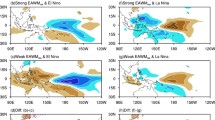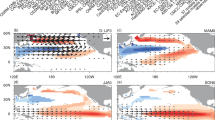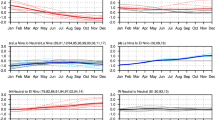Abstract
The El Niño-Southern Oscillation (ENSO) has seasonally distinct impacts on the East Asian climate so that its seasonal transition depends on the phases of El Niño and La Niña. Here, we investigate the seasonal transition of surface temperature in East Asia from boreal summer to winter based on the warm/cold ENSO developing phases. During La Niña years, from summer to winter the continuous temperature drop in East Asia tends to be faster than that during El Niño, indicating a latter start and earlier termination of fall. This different seasonal transition in East Asia according to phases of ENSO is mostly explained by atmospheric responses to the seasonally-dependent tropical/subtropical precipitation forcings in ENSO developing phases. The anomalous positive precipitation in the subtropical North Pacific exists only in September and leads to the subtropical cyclonic flow during El Niño years. The resultant northerly anomalies on the left side of the subtropical cyclone are favorable for transporting cold advection towards East Asia. However, the positive subtropical precipitation disappears and teleconnection to East Asia is strongly controlled by the negative precipitation anomalies in the western North Pacific, modulating the anticyclonic anomalies in East Asia during the early winter (November). Therefore, these seasonally sharp precipitation changes in the tropics/extratropics associated with ENSO evolution induce distinctive teleconnection changes from northerly (summer) to southerly (winter) anomalies, which eventually affect seasonal transition in East Asia. Also, the Coupled Model Intercomparison Project Phase 5 models reasonably simulate the relatively rapid temperature transition in East Asia during La Niña years, supporting the observational argument.










Similar content being viewed by others
Availability of data and material
The data from weather stations are provided by the CMA (https://data.cma.cn/), KMA (http://www.kma.go.kr/), and JMA (http://www.jma.go.jp/). The ERSSTv5 (https://psl.noaa.gov/data/gridded/data.noaa.ersst.v5.html), the CMAP (https://psl.noaa.gov/data/gridded/data.cmap.html), the ECMWF ERA5 (https://www.ecmwf.int/en/forecasts/dataset/ecmwf-reanalysis-v5), and the NCEP-DOE Reanalysis 2 (https://psl.noaa.gov/data/gridded/data.ncep.reanalysis2.html) data are downloaded from their website. The CMIP5 data used are available at http://cmip-pcmdi.llnl.gov/cmip5/.
Code availability
The codes for this study are available from the SK, upon reasonable request.
References
Chen W, Feng J, Wu R (2013) Roles of ENSO and PDO in the link of the East Asian winter monsoon to the following summer monsoon. J Clim 26:622–635. https://doi.org/10.1175/JCLI-D-12-00021.1
Gong H, Wang L, Chen W, Nath D, Huang G, Tao W (2015) Diverse influences of ENSO on the East Asian–western Pacific winter climate tied to different ENSO properties in CMIP5 models. J Clim 28:2187–2202. https://doi.org/10.1175/JCLI-D-14-00405.1
Ham YG, Kug JS (2015) ENSO amplitude changes due to greenhouse warming in CMIP5: role of mean tropical precipitation in the twentieth century. Geophys Res Lett 43:422–430. https://doi.org/10.1002/2015GL066864
Hardiman SC, Dunstone NJ, Scaife AA, Bett PE, Li C, Lu B, Ren H-L, Smith DM, Stephan CC (2018) The asymmetric response of Yangtze river basin summer rainfall to El Niño/La Niña. Environ Res Lett 13:024015. https://doi.org/10.1088/1748-9326/aaa172
Hersbach H, Bell B, Berrisford P, Hirahara S, Horányi A, Muñoz-Sabater J, Nicolas J, Peubey C, Radu R, Schepers D (2020) The ERA5 global reanalysis. Q J R Meteorol Soc 146:1999–2049. https://doi.org/10.1002/qj.3803
Horel JD, Wallace JM (1981) Planetary-scale atmospheric phenomena associated with the Southern Oscillation. Mon Weather Rev 109:813–829. https://doi.org/10.1175/1520-0493(1981)109%3c0813:PSAPAW%3e2.0.CO;2
Hoskins BJ, Karoly DJ (1981) The steady linear response of a spherical atmosphere to thermal and orographic forcing. J Atmos Sci 38:1179–1196. https://doi.org/10.1175/1520-0469(1981)038%3c1179:TSLROA%3e2.0.CO;2
Huang R (1992) The East Asia/Pacific pattern teleconnection of summer circulation and climate anomaly in East Asia. J Meteorol Res 6:25–37
Huang R, Sun F (1992) Impacts of the tropical western Pacific on the East Asian summer monsoon. J Meteorol Soc Jpn 70:243–256. https://doi.org/10.2151/jmsj1965.70.1B_243
Huang R, Wu Y (1989) The influence of ENSO on the summer climate change in China and its mechanism. Adv Atmos Sci 6:21–32. https://doi.org/10.1007/BF02656915
Huang B, Thorne PW, Banzon VF, Boyer T, Chepurin G, Lawrimore JH, Menne MJ, Smith TM, Vose RS, Zhang H-M (2017) Extended reconstructed sea surface temperature, version 5 (ERSSTv5): upgrades, validations, and intercomparisons. J Clim 30:8179–8205. https://doi.org/10.1175/JCLI-D-16-0836.1
Iwakiri T, Watanabe M (2020) Multiyear La Niña impact on summer temperature over Japan. J Meteorol Soc Jpn. https://doi.org/10.2151/jmsj.2020-064
Kanamitsu M, Ebisuzaki W, Woollen J, Yang S-K, Hnilo J, Fiorino M, Potter G (2002) NCEP–DOE AMIP-II reanalysis (R-2). Bull Am Meteor Soc 83:1631–1644. https://doi.org/10.1175/BAMS-83-11-1631
Kim S, Kug JS (2018) What controls ENSO teleconnection to East Asia? Role of western North Pacific precipitation in ENSO teleconnection to East Asia. J Geophys Res Atmos 123:10406–10422. https://doi.org/10.1029/2018JD028935
Kim S, Son H-Y, Kug J-S (2017) How well do climate models simulate atmospheric teleconnctions over the North Pacific and East Asia associated with ENSO? Clim Dyn 48:971–985. https://doi.org/10.1007/s00382-016-3121-8
Kim S, Son H-Y, Kug J-S (2018) Relative roles of equatorial central Pacific and western North Pacific precipitation anomalies in ENSO teleconnection over the North Pacific. Clim Dyn 51:4345–4355. https://doi.org/10.1007/s00382-017-3779-6
Kosaka Y, Nakamura H (2006) Structure and dynamics of the summertime Pacific–Japan teleconnection pattern. Q J R Meteorol Soc 132:2009–2030. https://doi.org/10.1256/qj.05.204
Kosaka Y, Xie S-P, Lau N-C, Vecchi GA (2013) Origin of seasonal predictability for summer climate over the Northwestern Pacific. Proc Natl Acad Sci 110:7574–7579. https://doi.org/10.1073/pnas.1215582110
Lee B-s (1979) A study of natural seasons in Korea. J Korean Geogr Soc 20:1–11
Lee JH, Julien PY (2016) ENSO impacts on temperature over South Korea. Int J Climatol 36:3651–3663. https://doi.org/10.1002/JOC.4581
Luo M, Lau N-C (2020) Summer heat extremes in northern continents linked to developing ENSO events. Environ Res Lett 15:074042. https://doi.org/10.1088/1748-9326/ab7d07
Meehl GA, Arblaster JM (2002) The tropospheric biennial oscillation and Asian–Australian monsoon rainfall. J Clim 15:722–744. https://doi.org/10.1175/1520-0442(2002)015%3c0722:TTBOAA%3e2.0.CO;2
Nitta T (1987) Convective activities in the tropical western Pacific and their impact on the Northern Hemisphere summer circulation. J Meteorol Soc Jpn 65:373–390. https://doi.org/10.2151/jmsj1965.65.3_373
Rasmusson EM, Carpenter TH (1982) Variations in tropical sea surface temperature and surface wind fields associated with the Southern Oscillation/El Niño. Mon Weather Rev 110:354–384. https://doi.org/10.1175/1520-0493(1982)110%3c0354:VITSST%3e2.0.CO;2
Son H-Y, Park J-Y, Kug J-S, Yoo J, Kim C-H (2014) Winter precipitation variability over Korean Peninsula associated with ENSO. Clim Dyn 42:3171–3186. https://doi.org/10.1007/s00382-013-2008-1
Son H-Y, Park J-Y, Kug J-S (2016) Precipitation variability in September over the Korean Peninsula during ENSO developing phase. Clim Dyn 46:3419–3430. https://doi.org/10.1007/s00382-015-2776-x
Tao SY, Chen L (1987) A review of recent research on the East Asian summer monsoon in China. Monsoon Meteorol 60–92
Taylor KE, Stouffer RJ, Meehl GA (2012) An overview of CMIP5 and the experiment design. Bull Am Meteorol Soc 93:485–498. https://doi.org/10.1175/BAMS-D-11-00094.1
Wang B, Wu R, Fu X (2000) Pacific-East Asian teleconnection: how does ENSO affect East Asian climate? J Clim 13:1517–1536. https://doi.org/10.1175/1520-0442(2000)013%3c1517:PEATHD%3e2.0.CO;2
Watanabe M, Kimoto M (2000) Atmosphere-ocean thermal coupling in the North Atlantic: a positive feedback. Q J R Meteorol Soc 126:3343–3369. https://doi.org/10.1002/qj.49712657017
Wittenberg AT, Rosati A, Lau N-C, Ploshay J (2006) GFDL’s CM2 global coupled climate models. Part III: Tropical Pacific climate and ENSO. J Clim 19:698–722. https://doi.org/10.1175/JCLI3631.1
Wu R, Hu Z-Z, Kirtman BP (2003) Evolution of ENSO-related rainfall anomalies in East Asia. J Clim 16:3742–3758. https://doi.org/10.1175/1520-0442(2003)016%3c3742:EOERAI%3e2.0.CO;2
Xie P, Arkin PA (1997) Global precipitation: a 17-year monthly analysis based on gauge observations, satellite estimates, and numerical model outputs. Bull Am Meteorol Soc 78:2539–2558. https://doi.org/10.1175/1520-0477(1997)078%3c2539:GPAYMA%3e2.0.CO;2
Xie S-P, Hu K, Hafner J, Tokinaga H, Du Y, Huang G, Sampe T (2009) Indian Ocean capacitor effect on Indo–western Pacific climate during the summer following El Niño. J Clim 22:730–747. https://doi.org/10.1175/2008JCLI2544.1
Xie S-P, Kosaka Y, Du Y, Hu K, Chowdary JS, Huang G (2016) Indo–western Pacific ocean capacitor and coherent climate anomalies in post-ENSO summer: a review. Adv Atmos Sci 33:411–432. https://doi.org/10.1007/s00376-015-5192-6
Yeh SW, Cai W, Min SK, McPhaden MJ, Dommenget D, Dewitte B, Collins M, Ashok K, An SI, Yim BY (2018) ENSO atmospheric teleconnections and their response to greenhouse gas forcing. Rev Geophys 56:185–206. https://doi.org/10.1002/2017RG000568
Yu T, Chen W, Feng J, Hu K, Song L, Hu P (2021) Roles of ENSO in the link of the East Asian Summer Monsoon to the ensuing Winter Monsoon. J Geophys Res Atmos 126:e2020JD033994. https://doi.org/10.1029/2020JD033994
Zhang R, Sumi A, Kimoto M (1996) Impact of El Niño on the east Asian monsoon. J Meteorol Soc Jpn 74:49–62. https://doi.org/10.2151/jmsj1965.74.1_49
Zhang R, Sumi A, Kimoto M (1999) A diagnostic study of the impact of El Niño on the precipitation in China. Adv Atmos Sci 16:229–241. https://doi.org/10.1007/BF02973084
Funding
This study is supported by the National Research Foundation of Korea (NRF-2018RA5A1024958).
Author information
Authors and Affiliations
Corresponding author
Ethics declarations
Conflict of interest
The authors have no potential conflicts of interest or competing interests to declare.
Additional information
Publisher's Note
Springer Nature remains neutral with regard to jurisdictional claims in published maps and institutional affiliations.
Supplementary Information
Below is the link to the electronic supplementary material.
Rights and permissions
About this article
Cite this article
Kim, S., Kug, JS. Impacts of ENSO on the seasonal transition from summer to winter in East Asia. Clim Dyn 58, 2593–2608 (2022). https://doi.org/10.1007/s00382-021-06019-w
Received:
Accepted:
Published:
Issue Date:
DOI: https://doi.org/10.1007/s00382-021-06019-w




